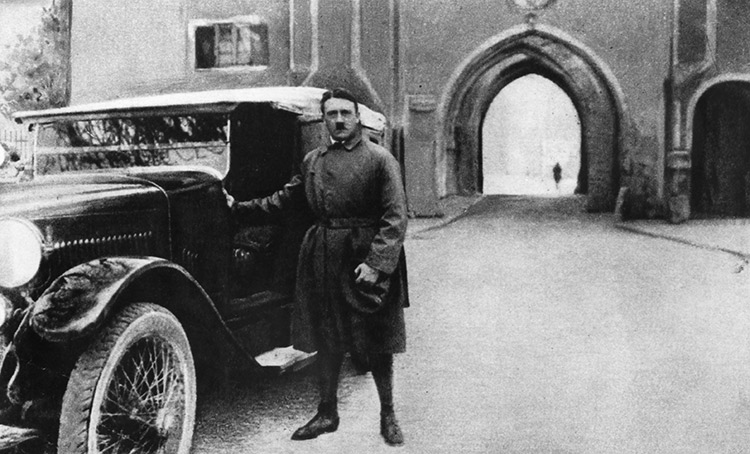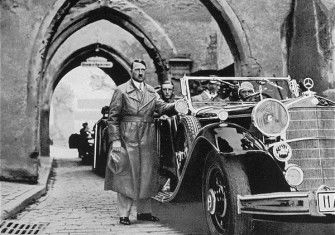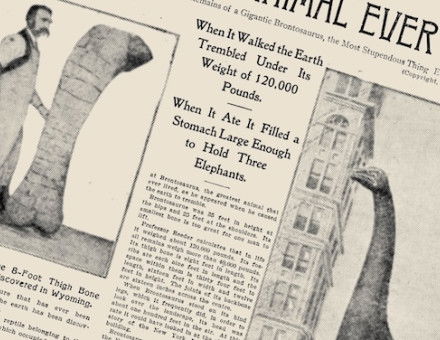Calling Time on Hitler's Hoax
A 90-year-old photograph of the future dictator soon after leaving prison still manages to fool the world’s media outlets.
 It is one of the most famous images of Adolf Hitler’s much-documented life. The future dictator of Germany poses rather stiffly by the running board of a Mercedes, in a buttoned and belted mackintosh, his hair slicked across his head, his trademark toothbrush moustache neatly clipped. Behind him stands a dark medieval gateway.
It is one of the most famous images of Adolf Hitler’s much-documented life. The future dictator of Germany poses rather stiffly by the running board of a Mercedes, in a buttoned and belted mackintosh, his hair slicked across his head, his trademark toothbrush moustache neatly clipped. Behind him stands a dark medieval gateway.
The picture was taken on December 20th, 1924, to mark Hitler’s release from Landsberg Prison in Bavaria, where he had spent nine months of a five-year sentence for treason and where he had penned his manifesto-cum-autobiography, Mein Kampf. Taken by Hitler’s photographer, Heinrich Hoffmann, it was intended to announce his release to Germany and the wider world, to proclaim that Hitler was ‘back’.
Circulated to the world’s press that day, the picture carried the caption ‘Hitler leaving Landsberg Prison’, written by Hoffmann himself. It quickly became a well-known image, with Hitler even re-enacting the scene for Hoffmann after his appointment as Chancellor in 1933. Yet, as so often, the picture is not all that it seems.
Landsberg fortress still stands today and is still a prison, but it has never had a grand medieval gate like the one in the picture; indeed, it was only opened in 1910. The gate shown is, in fact, the elegant late-Gothic Bayertor, southern-most entrance to the old town of Landsberg, a kilometre away across the River Lech. Why, then, the switch?
The story goes that Hoffmann, who had travelled from Munich to collect Hitler upon his release, had naturally wanted to record the event for posterity, but had been forbidden from doing so by a prison guard, who threatened to confiscate his camera if he persisted. Frustrated, Hoffmann drove the short distance to the Bayertor and got Hitler to pose for the photo there. As he confessed in his later memoir, he made the decision simply because the location offered ‘something of the fortress atmosphere’.
The world’s press swallowed the deception wholesale, with some even embellishing the story with headlines such as ‘The Fortress Gate has Opened’, even though the real fortress had no gate at all. Ever since, journalists, historians, archivists and students have followed suit, taking Hoffmann’s caption at face value and erroneously assuming that the ‘fortress-like’ gateway in the background of the photograph is the entrance to the prison.
It is a minor point, of course; a small corrective to an infinitely larger and more important story. But it does, nonetheless, illustrate a key aspect of that wider tale. It shows Hitler, and Hoffmann, not only as being acutely aware of the political importance of the image, but moreover willing to bend the truth in the process. In an age when the vast majority of politicians were blissfully ignorant of such apparently ephemeral matters, Hoffmann’s picture marked the dawning of a new era. It was the opening salvo in a concerted campaign of what we would today call ‘image management’, by which Hitler and Hoffmann meticulously crafted the public image of ‘the Führer’. It was a campaign that would continue throughout the 1920s and on to the very last days of the Third Reich.
What’s most remarkable, perhaps, is that the petty fiction that Hoffmann concocted that December day in 1924 is still with us, trotted out by editors and picture archives the world over and still repeated ad nauseam on the myriad pages of the Internet. Perhaps now it is finally time to consign this small piece of Nazi propaganda to the dustbin of history.
Roger Moorhouse is the author of His Struggle: Adolf Hitler in Landsberg, 1924.






